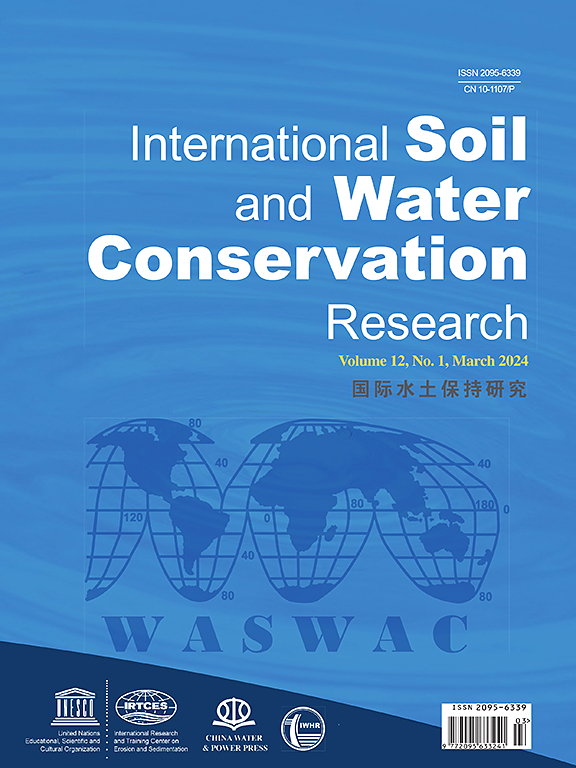黄河中游大泥沙生成区和粗泥沙等级区的风力和降雨侵蚀能量
IF 7.3
1区 农林科学
Q1 ENVIRONMENTAL SCIENCES
International Soil and Water Conservation Research
Pub Date : 2024-06-12
DOI:10.1016/j.iswcr.2024.06.001
引用次数: 0
摘要
在黄河中游产沙大、粗沙类地区,强风和强降雨的共同作用导致了严重的水土流失问题。研究风、雨的变化趋势和交变能是控制区域输沙问题的重要前提。利用空气动力能和降雨动能公式计算了风蚀能和降雨侵蚀能。采用Mann-Kendall (MK)趋势检验和Theil-Sen方法,分析了近40 a(1979-2018)流域联合侵蚀能的时空变化特征。结果显示如下。1)风蚀能增大,雨蚀能减小。然而,前者比后者更大。2)不同季节优势侵蚀能不同。春季以风侵蚀能为主,夏季以雨侵蚀能为主。3)侵蚀能有规律的风-雨-风交替。降雨能在5 - 7月交替分布,雨-风能在9 - 12月交替分布。降雨侵蚀能的优势时间随着风蚀能的增加而减少。研究结果可以帮助决策者制定水土流失控制策略,以减少水土流失在风、水交错地区的发生。本文章由计算机程序翻译,如有差异,请以英文原文为准。
Wind and rainfall erosion energy in large sediment generating and coarse sediment class areas of the middle Yellow river
Joint action by strong winds and high-intensive rainfall leads to serious soil erosion problems in large sediment generating and coarse sediment class areas of the middle Yellow River. Investigating the variation of trend and alternating wind and rainfall energy is an important prerequisite for controlling regional sediment transport problems. We calculated the wind and rainfall erosion energies by using the aerodynamic energy and rainfall kinetic energy formulas. The Mann-Kendall (MK) trend test and Theil-Sen approach were used to analyze the spatial-temporal variation and alternation of joint erosion energy during the last 40 years (1979–2018). The results show the following. 1) Wind erosion energy increased and rainfall erosion energy decreased. However, the former is larger than the latter. 2) The dominant erosive energy varies for different seasons. Wind erosive energy dominates in spring, and rainfall erosive energy dominates in summer. 3) There is a regular wind-rainfall-wind alternation of erosive energy. The wind-rainfall energies were alternately distributed in May–July and the rainfall-wind energies were alternately distributed in September–December. Furthermore, the dominant time of rainfall erosive energy decreased when wind erosive energy increased. The results can help decision makers to develop soil erosion control strategies to reduce soil erosion when it occurs in wind and water staggered areas.
求助全文
通过发布文献求助,成功后即可免费获取论文全文。
去求助
来源期刊

International Soil and Water Conservation Research
Agricultural and Biological Sciences-Agronomy and Crop Science
CiteScore
12.00
自引率
3.10%
发文量
171
审稿时长
49 days
期刊介绍:
The International Soil and Water Conservation Research (ISWCR), the official journal of World Association of Soil and Water Conservation (WASWAC) http://www.waswac.org, is a multidisciplinary journal of soil and water conservation research, practice, policy, and perspectives. It aims to disseminate new knowledge and promote the practice of soil and water conservation.
The scope of International Soil and Water Conservation Research includes research, strategies, and technologies for prediction, prevention, and protection of soil and water resources. It deals with identification, characterization, and modeling; dynamic monitoring and evaluation; assessment and management of conservation practice and creation and implementation of quality standards.
Examples of appropriate topical areas include (but are not limited to):
• Conservation models, tools, and technologies
• Conservation agricultural
• Soil health resources, indicators, assessment, and management
• Land degradation
• Sustainable development
• Soil erosion and its control
• Soil erosion processes
• Water resources assessment and management
• Watershed management
• Soil erosion models
• Literature review on topics related soil and water conservation research
 求助内容:
求助内容: 应助结果提醒方式:
应助结果提醒方式:


